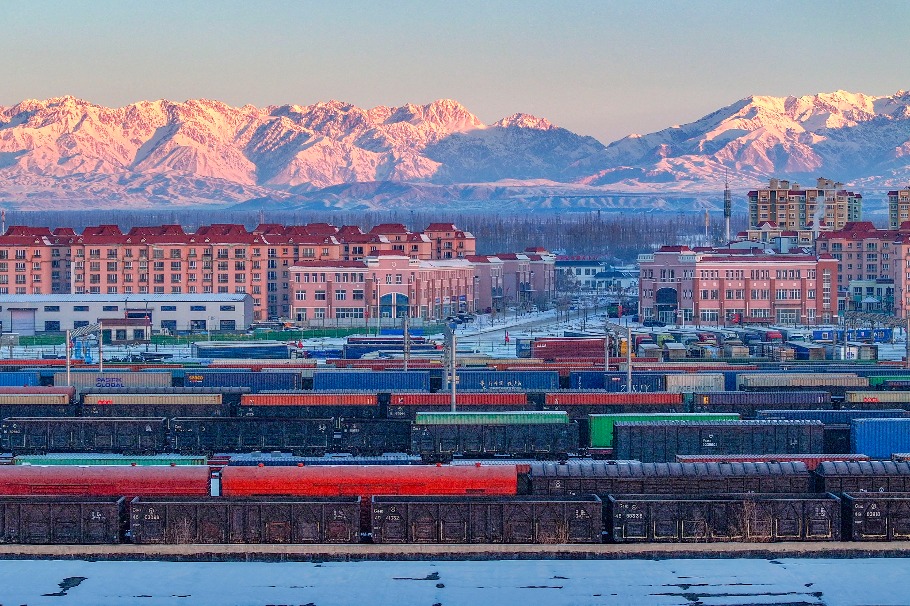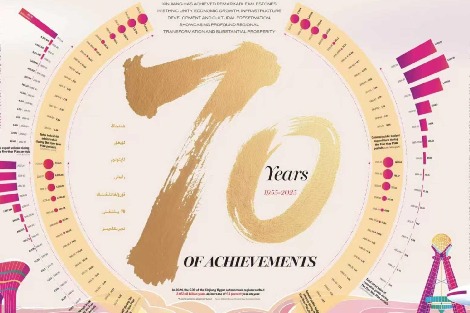White paper: Democratic Reform in Tibet (full text)

V. Liberating and Developing the Productive Forces
Democratic reform in Tibet abolished the feudal bondage of individual serfs to serf owners, and enabled the people to be masters of their own affairs. It replaced serf owners' land ownership with peasants' land ownership, which allowed serfs to own means of production and significantly liberated and developed productive forces. Since China adopted reform and opening up in 1978, the productive forces in Tibet have developed rapidly and have now caught up with the national level; the people in Tibet are sharing more and more achievements of modern civilization.
-Improving productive forces
Democratic reform in Tibet enabled the former serfs to own their own land, farm tools, cattle and other means of production. They showed ever growing passion for working hard to create wealth. Agriculture and animal husbandry progressed significantly.
From 1959 to 1960, calculated at comparable prices, Tibet's GDP grew by 45.8 percent and its per capita GDP rose by 42.9 percent, both of which represented a historical high. From the winter of 1959 to the spring of 1960, 1,500 km of new water channels were built and 300 reservoirs were repaired in the agricultural areas, adding more than 24,666 ha of irrigated land. In 1960 as a whole, 5,000 km of new water channels were built along with 1,500 new reservoirs and ponds, which further expanded the area of irrigated land. From the winter of 1959 to the first half of 1960, Tibet collected 1.1 million tons of fertilizer. By the spring of 1960, arable land had expanded to an area of 182,000 ha, an increase of 20,000 ha over 1959.
Agricultural development led to significant improvements in the lives of peasants and herdsmen. Take the example of Khesum Township of Nedong County (present-day Nedong District). In the early days of democratic reform, 90 of its total of 119 rural households suffered food shortages; by 1964, all of its rural households had sufficient grain, seed stock, and fodder, and 95 percent of them had surplus grain. By the end of 1961, Tibet's total livestock inventory reached 12.06 million heads, surpassing the highest recorded figure before the 1959 rebellion.
The central government provided farm tools to peasants in Tibet who had acquired land. For example, some 367,000 metal farm tools were given free to the peasants and herdsmen. In the following years, the central government distributed several hundred thousand farm tools, and built small farm tool manufacturing factories in Lhasa, Qamdo, Shigatse, Gyantse, Tsethang, Nyingchi and other cities.
After democratic reform, the central government adopted a policy of steady development based on the real conditions in Tibet. In 1961, the CPC Tibet Working Committee issued Specific Policies Towards the Rural Areas and Regulations on the Current Policies Towards the Pastoral Areas, which received heartfelt support from officials and the public. By 1965, Tibet's total grain yield had reached 290,000 tons, up by 66.1 percent over 1958; its total livestock inventory was more than 17.01 million head, up by 54.1 percent over 1958.
From 1958 to 1965, Tibet made major progress in transport, education, culture, healthcare and other social undertakings. By 1965:
? Tibet had a total of 14,721 km of highway, up by a factor of 2.6 compared with 1958, connecting 90 percent of all its counties;
? There were eight new asphalt roads in downtown Lhasa;
? More than 95 percent of Lhasa residents had access to electric lighting;
? There were:
? 1,822 primary schools with 66,781 students,
? four middle schools with 1,359 students,
? one secondary vocational school, and
? one institution of higher learning.
? Tibet had 133 professional art troupes and cinemas;
? The number of medical institutions had increased to 193, more than three times the number in 1958;
? The number of hospital beds had risen to 1,631, 3.4 times the number in 1958;
? There were 2,947 healthcare workers, 3.7 times the number in 1958.
In 1966, Nyingchi Woolen Mill was established and put into operation-the first modern wool textile mill in Tibet's history. In 1965, the China-Nepal Highway, connecting Tibet and Nepal, was completed and opened to traffic. In 1973, the Yunnan-Tibet Highway opened to traffic.
-Accomplishing a fundamental change in economic structure
Through 60 years of hard work, agriculture and animal husbandry in Tibet is no longer subject to nature and the environment; it is steadily modernizing. The added value of agriculture, forestry, animal husbandry, fisheries and related service industries rose from 128 million yuan in 1959 to 13.41 billion yuan in 2018. Grain yield increased from 182,900 tons in 1959 to more than 1 million tons in 2018; grain yield per unit area increased from 1,370 kg/ha in 1959 to 5,688 kg/ha in 2018. Specialty industries related to agriculture and animal husbandry have grown in size and productivity. Tibetan plateau brands have been established in agriculture and animal husbandry. A large group of specialty industrial bases have been created, such as high-quality grain and oil production, pollution-free vegetables, large-scale standardized dairy cattle farming, Tibetan pig farming, Tibetan chicken farming, and cashmere goat farming.
Modern industry started from scratch and has grown steadily. Through 60 years of development, Tibet has now established a modern industrial system covering over 20 sectors, including energy, construction materials, machinery, mining, light industry, food processing, ethnic handicrafts, and Tibetan medicine. Tibet has abandoned its traditional industrial model and is approaching modernized levels of production. Tibet's industrial added value increased from 15 million yuan in 1959 to 11.45 billion yuan in 2018.
Economic aggregate has achieved significant growth. In 2018, Tibet's GDP was 147.76 billion yuan, about 192 times the 1959 figure of 174 million yuan, calculated at comparable prices. Tibet's economic structure is improving. The share of added value from primary industry in GDP dropped from 73.6 percent in 1959 to 8.8 percent in 2018, while the share of secondary industry rose to 42.5 percent and the share of tertiary industry increased to 48.7 percent.
Tertiary industry is thriving, and tourism is developing rapidly. In 2018, Tibet received 33,687,300 tourist visits, with a total tourism revenue of 49.01 billion yuan. More than 100,000 farmers and herdsmen have added income through tourism, and Tibet has become an international tourist destination. Trade logistics, banking, insurance, e-commerce, logistics, and other new forms of industry have grown fast and have become new sources of growth.
-Improving infrastructure
Tibet had no proper highways before its liberation in 1951, when highway construction in the modern sense began. Despite economic difficulties, China built the Qinghai-Tibet Highway, Sichuan-Tibet Highway and other low-grade highways connecting Tibet with other regions. After democratic reform, trunk highways such as the Xinjiang-Tibet Highway, Yunnan-Tibet Highway, and China-Nepal Highway were built. The Qinghai-Tibet Highway and Sichuan-Tibet Highway were asphalted, and a high-grade highway connecting downtown Lhasa and Gongkar Airport was completed. Now Tibet has formed a comprehensive transport network composed of highways, railways and air routes. By the end of 2018, Tibet had 97,800 km of highway, 660 km of which were high-grade highways. All counties in Tibet had access to highways, and of the 697 townships and towns, 579 had direct access to highway transport and 696 could be reached by highways. Of the 5,467 villages in Tibet, 2,624 had direct access to highway transport and 5,457 could be reached by highway. In 2006, the Golmud-Lhasa section of the Qinghai-Tibet Railway was completed and opened to traffic, which was the first railway in Tibet. In 2014, the construction of Lhasa-Shigatse Railway was completed and tracklaying started on the Lhasa-Nyingchi Railway.
The construction of air stations and airports is progressing. In 1956, the first airstrip in Tibet was completed. Tibet now has five airports and 92 domestic and international air routes in operation. There is an airline network with Gongkar Airport in Lhasa as the main hub, and with Bamda Airport in Qamdo, Mainling Airport in Nyingchi, Gunsa Airport in Ngari, and Peace Airport in Shigatse as branches.
Before liberation in 1951, Tibet had only one 125-kw hydropower station, which supplied electricity only to a handful of aristocrats. In 1960, Ngachen Hydropower Station was completed and entered service, bringing electric lighting for the first time to the citizens of Lhasa. Subsequently, many more hydropower stations were completed, including Yamdrog Hydropower Station, Wiga Hydropower Station, Tralong Hydropower Station, Jinhe Hydropower Station, Drigung Hydropower Station, Shiquanhe Hydropower Station, Shoka Hydropower Station, Laohuzui Hydropower Station, Dzam Hydropower Station, Tobe Hydropower Station, Godok Hydropower Station, and Joba Hydropower Station. Yangbajain Geothermal Power Station has also been completed, as have a series of large grid-connected PV power plants. A comprehensive energy network is in place, with hydro power as the mainstay, and supplemented by oil, natural gas and renewables. The power supply in Tibet has been grid-connected with those in Qinghai and Sichuan provinces. Tibet's urban heating system has been greatly improved. In the winter of 2014, natural gas heating became available in downtown Lhasa, meeting the everyday needs of Lhasa residents. By the end of 2018, Tibet's power grid had extended to 62 counties (districts), supplying electricity to a population of 2.72 million; the other areas in Tibet had full power supply through small hydropower stations, local PV networks, and household PV systems.

































